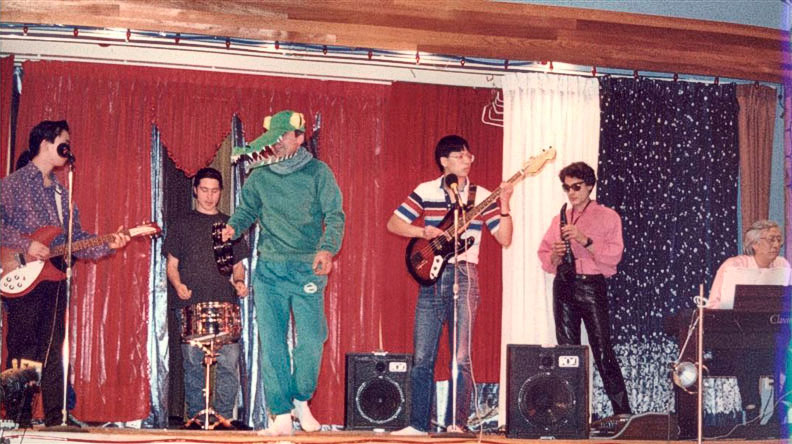A Parenting Scene: Contact Makes All The Difference
INT. SCENE – DESCRIPTION
Crowded waiting room at a doctor’s office. Some people are making resigned sighs and shifting in their chairs due to the fact that they have been waiting a little too long. There are three health practitioners sharing the space and behind a long, high counter, there is an assistant interacting with the telephone, a computer and patients. At the counter there is a parent with two small children needing to book a follow-up appointment for one of the children.
CHARACTERS –
PAT – A parent (could be mom or dad) with two young children – aged 4 and 20 months
CHRIS – a 4-year-old child (could be boy or girl) – tagging along
MORGAN – an 18-month-old child – (could be boy or girl) needs a follow up appointment
CAREY – a 24-year-old medical assistant (could be female or male) – single – no children
DIALOGUE –
PAT (parent with two small children): I need to make a follow-up for MORGAN. So what are your hours?

CAREY (medical assistant): Well – Of course we are closed on weekends, but Monday is always 8 to 5. Tuesday is 9 to 4 – but then every other Tuesday we go to 6. Wednesday is 11 to 7 and so is Thursday but Friday afternoons we are closed. We take Friday afternoons off.
(MORGAN, 18-month-old child begins by pulling at PAT’s leg. PAT tries to ignore the pull.)
PAT: Uh, what did you say – Monday?
(MORGAN begins pulling PAT’s coat hem to amplify the plea as PAT’s body leans to one side in response.)
CAREY: 8 to 5.
PAT: (Checking wildly about for CHRIS, the 4-year-old, notices with a gasp that CHRIS has discovered the water cooler in the doctor’s office). The days you have evening times…
(MORGAN whimpers, then whines, then adds some stomping, which gains in intensity until it looks like a dance designed to attract demons. Pat beginning to feel a little demonic thinks it might be working.)
PAT: NO! MORGAN!! CHRISsss! Uh … sorry. (It is unclear whether this sorry is intended for Carey, the medical assistant or for the room).
(CHRIS, 4-year-old child. is pretending to be a camel that has found an oasis and is filling up tiny cup after tiny cup with water. Unfortunately, they are the cone-type paper cups that can’t be placed on the magazine table without spilling.)
PAT (Abandoning CAREY rushes over to CHRIS – needing to extend one leg backwards as MORGAN is now attached like a bear cub to a small pine tree): Chriiiiissss – Don’t play with the water now. Leave that alone and get over here with me. You’ll get the magazines wet.
CHRIS: But I’m really thirsty. I am a camel! Me and my friends are really thirsty and I need to cross the safari desert.
PAT: That’s “Sahara desert” and get over here now!
MORGAN: WAAAAAAA!!!!
CAREY: Every other Tuesday we go to 6 and Wednesdays we go to 7 – we are closed Friday afternoons. We take Friday afternoons off.
PAT: Friday afternoons off – sounds good! Must be ni––––MORGAN, CHRIS sit down – here! Now! Right now! I mean it!
(MORGAN glances at the chair and scrutinizes the woman sitting next to it, rejects the chair and the woman off-hand with a tiny, but telling snort and resumes the insistent stomping and whining. The woman’s “harumph” is followed by PAT’S sharp intake of a short breath through gritted teeth.)
By now, everyone in the waiting room is looking at PAT, CHRIS and MORGAN – or even worse looking away – PAT takes in smug profiles, slightly pursed lips, raised eyebrows and barely audible “tsk – tsk’s”. A red heat starts at PAT’s neck and begins to move up PAT’s face – hitting PAT’s ears so hard they could attract hummingbirds.
(CHRIS looks at PAT’S face and understands that things might be getting a little out of hand, but CHRIS’s concern for the needs of the desperately thirsty pretend camels that are stumbling out of the pretend shimmering desert overrides any concern for PAT’S real-life parental needs.)
PAT: STOP IT BOTH OF YOU! GET OVER HERE RIGHT NOW! LET’S GET OUT OF HERE! You two are driving me crazy – can’t just let me have a simple conversation with anyone…..(PAT’s rant, too indelicate to faithfully record here, devolves into derisive muttering and is punctuated with head–shaking, finger–pointing and brusque strides that force the children to follow PAT – mollified, cautiously – at a bit of a distance. Children, now fully subjugated, know they are in trouble and begin to cry…..)
PAT: (Over shoulder to CAREY as PAT collects jackets and MORGAN’s toy dog.) – I’ll phone you tomorrow to make an appointment. What day is it tomorrow? What are your hours?
Unfortunately PAT leaves CHRIS’s small, treasured polar bear behind. CHRIS was imagining that the toy bear was searching for ice floes on the flooded magazine table. The loss of the polar bear, which CHRIS wants to take to Grandma and Grandpa’s on Saturday won’t be noticed until Friday afternoon. And of course, they have Friday afternoons off…!)
…………….
SCENE
In this scene, I was PAT the parent. We have all been there – overwhelmed, embarrassed, frustrated and at odds with our children. How could I have handled this situation differently? Is there anything I could have done to make things more pleasant for all and at the same time support the development of CHRIS and MORGAN?
To begin our anatomy of a scene, let’s take a quick look at the whole talk situation. The talk situation is me with my children talking to another person. Instead of staying in contact with my children while I am talking to CAREY, I cut off contact with the children and make contact with CAREY more important.
As soon as I began to talk to CAREY, for some reason I decided to tune my children out. Perhaps my belief was that scheduling is something I can’t do with them around so I tune them out. Even though I am making an appointment for MORGAN, I am unable to be in contact with MORGAN at the same time.
Children, especially children MORGAN’s age, are keen to learn about social interaction. They love being in contact with their parents while their parents are talking with other people. They monitor their parents’ body, facial and voice reactions to other people in order to make sense of things. The counter in the doctor’s office is high. MORGAN can’t see CAREY and may simply want to check out the interaction. If this is what is happening, somehow find a way to stay connected with your child even when you are in an interaction with someone else. How can this be accomplished?
Suggestion– Pick MORGAN up so that MORGAN can see CAREY and understand the interaction. Put MORGAN on the counter – or if picking up and placing MORGAN on the counter is not feasible – fill MORGAN in on the talk situation.
You could say in a non-patronizing way – Parent: I am talking to CAREY now. We are arranging something.
Learn to make contact with your child so that they understanding the following to be the case: “I know that this is not too interesting, MORGAN. We’ll get back to more meaningful contact soon – hang tough. I know you can do it. I’m here and if you really need something I will pay immediate attention to you, ok?”
These are too many words to say to a child in one turn at talk. Over time, I learned how to do this with eye contact, touch and presence.
Regarding Chris, I could have acknowledged what Chris was doing and redirected Chris’s attention. Something like:
PAT: Oh, I see you found the water cooler. Could you please bring me a small cup of water? I’m not a camel, but I get thirsty too. I am talking to CAREY for just another minute then we need to get going, ok?
This approach accomplishes a few things. Firstly, CHRIS’S activity is acknowledged in a positive way. Asking CHRIS to bring Pat the water, rather than watering imaginary camels on the magazine table, doesn’t just distract CHRIS which can be somewhat patronizing for a 4 year old. Rather, CHRIS is now involved in a relational, helpful task and is using the water cooler in the way the doctor’s office most likely intended. Moreover, notice that PAT does not pretend to be a camel asking for water. PAT should not abandon the parent role in this situation, but find a way to be respectful and contactful without being patronizing. All of this can be accomplished in this social interaction without making CHRIS wrong.
It is helpful to realize that there are some really simple things we need to learn about the child’s perspective of the world and how they are developing that provide ease and meaning to social interaction with our children.
What’s the main gist? The main gist is to stay in contact in a meaningful way that is respectful, matter of fact, considerate, laced with perspective taking and not at all patronizing. This is actually easier than it sounds. The benefits for you and your children are manifold.
When you make strong contact with your child using your whole self, your child relaxes, responds, complies, contributes, and learns. This actually frees you to breathe, think and relax. When you resist making this type of meaningful contact your child insists on this contact one way or another. Usually this insistence is troublesome and problematic. Often we resist making solid contact with our children because we believe there will be no end to it – we will be sucked into a black hole and never have a minute for ourselves. Alternatively, we may believe that we are pandering to our child and we need to be firmly in control to ensure a good outcome. Whatever the source of our resistance, the benefits of making solid contact with your child tend to outweigh the difficulties.
Do come to Personal Parenting with myself and Toby Macklin to learn more about this and other fascinating topics near and dear to parents. The aim is to provide pragmatic tips, which have surprising profound underpinnings, that will support you to increase harmony, health and happiness in your family life.
Thanks, Denise Goldbeck
Curious to find out more about what happens at Personal Parenting? There are some surprise activities that enhance participants’ perspectives of their children, along with deep discussions about how to prepare our children for an increasingly precarious-looking future. In and amongst this mix, we also provide direct teaching about how to make your life as a parent easier, more fun, and more meaningful for you in terms of your own development as a person. Our motto – Solid time in with your child, not only provides the recognition that your child needs to develop optimally, but it also leads to solid time out for you!







